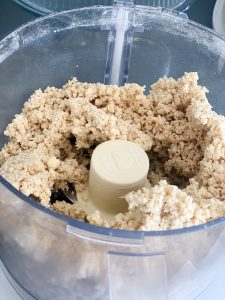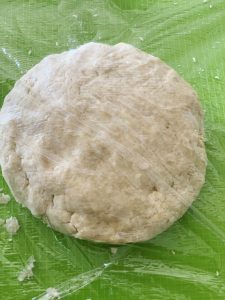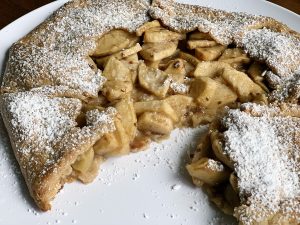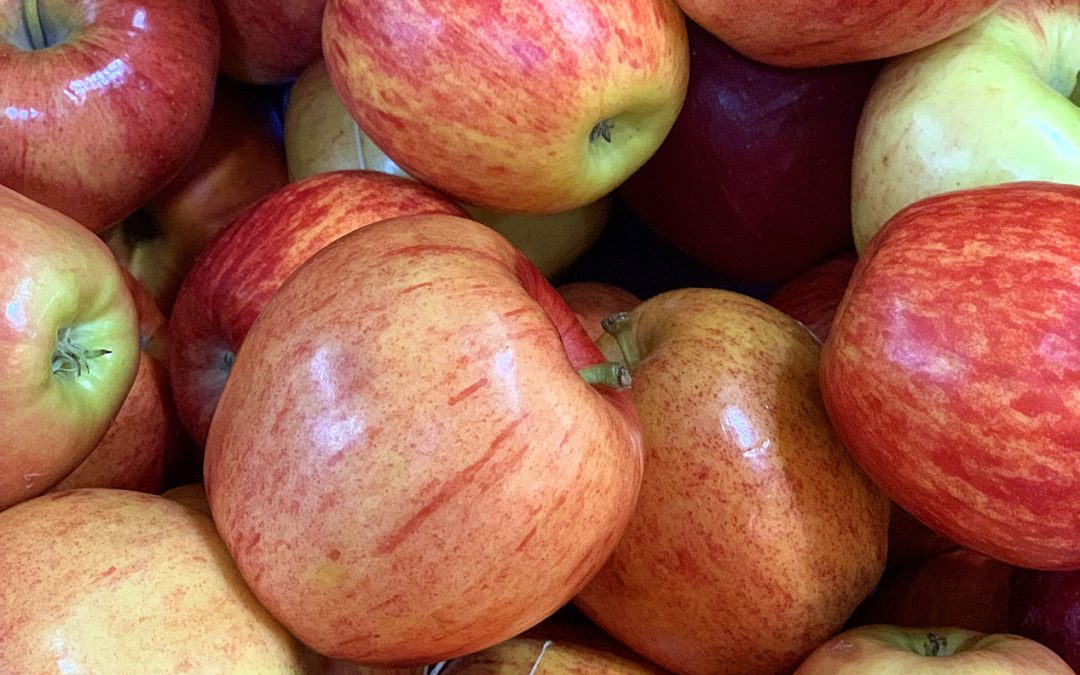Story & Photos By GAIL BLAKELY
Farmers markets in the fall have a special feeling. Bittersweet is perhaps the best way to describe it. We look back over the year and remember the first signs of spring: chives and fiddleheads, then strawberries. Soon it’s radishes, peppers and garlic scapes, then we move on to tomato season, replete with basil and other fresh herbs that seem to make the summer season complete. We cannot ignore the glories of stone fruits: peaches and plums that are so juicy that they need to be eaten over the sink.
As the season moves along, we have a sense that all this fresh produce will be coming to an end soon. Perhaps that’s what makes the fall markets so distinctive—we are counting the days until the ground is frozen and much of our produce is available only in supermarkets. The days are cooler, and home cooks are willing to spend a little more time in the kitchen, canning and freezing the bounty of the season past.
As we shop the farm stands we should remember that local farmers offer food that is bred for taste and freshness, rather than shipping and long shelf life. This means that we are able to enjoy exceptional taste in the foods that are perfectly ripe, flavorful and carefully harvested. Our farmers work hard to keep their food safe so that we can put healthy food on the table, and they make sure that future generations will inherit a healthy planet.
Supporting our endangered family farms is critical, and buying locally grown food strengthens the economy, as it keeps our money circulating in the Cape Cod community. In addition, knowing where your food comes from allows you to make better-informed decisions about your food choices. More importantly, shopping local serves to protect the environment, as the food doesn’t have to travel far, thus reducing carbon monoxide emissions and packaging materials.
Many home cooks have tried-and-true ways to showcase their fall market finds. Apples, grapes and pears become common ingredients, as do the winter squash, pumpkins and root vegetables such as potatoes—in all their wondrous colors. Hardier greens add both color and fiber to our meals: swiss chard, collards, kale and Asian greens. And we cannot ignore other brassicas such as turnips, broccoli, cauliflower and Brussels sprouts.
Pastry goes exceptionally well with almost all of the above. One of my favorite ways to make use of this fall abundance is to present it in a pastry shell. That might be a pie—of course, a quintessential New England apple pie or a Cape Cod cranberry pie. Nowadays we can easily purchase decent premade pastry in our markets (both the chilled variety as well as the frozen are equally good choices).
With a little forethought, however, the home cook can have a stash of his or her own ready to roll. I discovered this whole wheat crust at www.food52.com, where Emma Laperruque borrowed a technique from her grandmother, who used this particular dough for her rugelach, a Jewish staple. It’s relatively simple to make and uses white whole wheat flour, which is milled from white wheat.
Usually whole wheat pie pastry uses a mixture of whole wheat and all-purpose flours, which can result in dense baked goods. White whole wheat flour is lighter in color, milder in flavor and much more forgiving in most recipes. In addition, this is not a standard butter or shortening recipe, but rather one that incorporates butter and cream cheese, which makes it more tender and flaky. The cream cheese adds moisture, so no water is required.
You can make a pie, which is homey, or a tart, which is a little more fancy. Or you can choose to go with a more rustic pie, a galette, which is sort of in between. An open-face pie is also called a crostata (in Italian) or “flat pie,” if you will. The filling can be sweet or savory—your choice.
Here’s the recipe for this dough, which I believe you will find extremely easy to make—and use. The eating is pretty good as well.
White Whole Wheat
Galette Dough
1 cup white whole wheat flour, cold
½ tsp kosher salt
4 oz cream cheese, broken into pieces
4 oz unsalted butter, cubed

Galette dough in the food processor
If possible, chill or freeze your flour before using. Place the flour and salt in a food processor, and pulse just to combine. Add the cream cheese, and pulse until totally incorporated, with no big pieces visible. Add the butter, and continue to pulse until the butter is totally incorporated and the mixture is curdy, almost like cottage cheese, easily holding together when squeezed. Form into a disk, and tightly wrap in plastic. Refrigerate for at least 30 minutes and up to two days before using. To use, on a lightly floured surface, roll out the dough to a circle about 12 inches in diameter. At this point, you can make the pastry in any way you would like:

Galette dough ready to roll out
For a free-form galette, transfer the dough to a parchment-lined sheet pan, add your filling to the center, leaving a 1-inch or so border, and then fold over that border to form a crust.
For a par-baked crust, place into a 9-inch pie pan and crimp however you like. Prick the bottom and sides with a fork, line with parchment and fill with pie weights. Bake at 400 degrees Fahrenheit for 15 to 20 minutes, until the crimped crust is starting to brown. Remove from the oven, remove the parchment and pie weights, and bake for another 5 to 8 minutes to dry out the bottom. (If the crust puffs up at all or starts to shrink, you can prick it with a fork to depuff, or push up the shrunken sides with the side of a measuring cup.)
For a blind-baked crust, place into a 9-inch pie pan and crimp however you like. Prick with a fork, line with parchment and fill with pie weights. Bake at 400 degrees Fahrenheit for 15 to 20 minutes, until the crimped crust is starting to brown. Remove from the oven, remove the parchment and pie weights, and bake for another 12 to 15 minutes to bake fully until deeply golden brown. (If the crust puffs up at all or starts to shrink, you can prick it with a fork to depuff, or push up the shrunken sides with the side of a measuring cup.)
Once you have your pastry ready to fill, you may choose from any of the following recipes, or make up your own! Once you have a few of these pastry disks in your refrigerator (or freezer), you are more than halfway to making a gourmet galette.
Plum Crostata
(Adapted from
www.jovinacooksitalian.com)
Note: For this recipe you want firm but slightly ripe plums, and preferably freestones, such as the Italian prune plums.
2 pounds firm ripe Italian prune plums, cut into sixths or eighths
1 TBSP lemon juice
1 TBSP Cognac
1 TBSP potato starch
¼ cup granulated sugar
¼ teaspoon salt
1 recipe galette dough
Preheat oven with pizza stone to 400 degrees Fahrenheit. Combine lemon juice, Cognac, potato starch, sugar and salt; pour over plums. Toss carefully to coat, and let macerate for 10 minutes. Roll out dough on a sheet of lightly floured parchment paper to 12 inches in diameter. Carefully lay dough with parchment paper on a baking sheet. Pour plums and their juices onto the dough, spreading them out in an even layer and leaving a border around the edge. Fold up about a 2-inch border of dough, overlapping and folding when necessary. Bake for 40 minutes until the plum juices are bubbling and the crust is golden brown. Let cool for at least 10 minutes before cutting and serving. Yield: 6 servings.
Leek And Bacon Pie
(Adapted from www.food52.com)
4 thick slices bacon
2 cups chopped leeks (both white and pale green sections)
1 clove garlic, finely chopped
2 extra large eggs
1 cup crème fraîche (or sour cream)
1 TBSP AP flour
½ tsp sea salt
¼ tsp freshly ground white pepper
Dash of hot pepper sauce
1 recipe galette dough
Heat oven to 375 degrees Fahrenheit; fry the bacon, drain well and cut the crisp strips into half-inch pieces. Sauté the leeks and garlic in the bacon fat until soft; let cool slightly. Meanwhile, roll out the galette dough on a lightly floured piece of parchment paper, and place it in a 9-inch pie pan. Spread the leek mixture and the bacon over the middle of the galette dough. Beat the eggs in a medium-sized nonreactive bowl; blend in the remaining ingredients. Pour the mixture over the leeks and bacon, and crimp the edges, if desired, or fold them gently over the top of the pie to make a more rustic galette. Bake for 45 minutes; the custard should still be shaky in the center. Allow to sit for 10 or 15 minutes before serving; this is good served at room temperature also.
Apple Tart With
Concord Grapes
(Adapted from Ian Knauer)
Late summer/early autumn affords the perfect opportunity to make this tart—that’s when the seasons of Concord grapes and early apples overlap. Make the tart into a rectangular shape to fit all of the fruit filling.

This is why it is called a “flat pie.”
½ cup light brown sugar
2 tsp finely grated orange zest
¼ cup orange juice
½ tsp cinnamon
¼ tsp each: freshly grated nutmeg and kosher salt
5 Gala or McIntosh apple
½ cup Concord grapes
1 recipe galette dough
Make the filling: Whisk together the brown sugar, orange zest, juice, cinnamon, nutmeg and salt in a large bowl. Peel and core the apples, then slice them and add to the sugar mixture. Cut the grapes in half, remove the seeds, then toss them with the apples.
Preheat the oven to 425 degrees Fahrenheit, with a rack in the middle. On a floured piece of parchment paper, roll out the pastry dough with a floured rolling pin into a 10-by-7-inch rectangle. Transfer the dough to a half-sheet pan, on the paper, and crimp the edges. Pour the filling onto the dough, spreading evenly.
Bake the tart until the crust is golden, the filling is bubbling and the apples have started to brown, about 45 minutes. Cool the tart slightly on a rack. Serve warm or at room temperature.
Sweet Potato Galette With Caramelized Shallots
(Adapted from
www.howsweeteats.com)
2 shallots, thinly sliced
2 TBSP unsalted butter
¼ tsp salt
1 tsp brown sugar
2 sweet potatoes, peeled and very thinly sliced
6 oz goat cheese, crumbled
1 recipe galette dough
Pepita Gremolata
1 TBSP roasted pepitas
1½ TBSP olive oil
1 tsp fresh lemon juice
2 TBSP each: chopped flat leaf parsley and chopped fresh basil
1 garlic clove, minced
Heat the butter in a skillet over low heat; stir in the shallots with the salt. Cook on low heat, stirring occasionally, until the shallots are caramelized, 35 to 45 minutes. Stir in the brown sugar, and cook for 10 more minutes; remove from the heat and set aside. Slice the sweet potatoes into paper-thin rounds (use a mandoline if you have one). Roll out the galette dough on a lightly floured piece of parchment paper, to a thickness of a quarter inch. Place the dough with the paper on a baking sheet. Add the sweet potatoes in the center, alternating layers between sweet potato rounds, caramelized shallots and crumbled goat cheese, leaving a 2-inch+ border of crust. Sprinkle the layers of sweet potato with salt and pepper; once the filling is added, fold the crust over the top of the squash. Bake the galette until the crust is golden, 45 to 50 minutes. Meanwhile, combine the ingredients for the gremolata in a small food processor, and pulse to combine. Let the galette cool slightly, then brush it with the gremolata before serving.

Cheesy broccoli tart
Broccoli And Cheesy
Cheddar Tart
(Adapted from www.epicurious.com)
1 10-ounce package frozen broccoli florets, thawed, or 2 cups chopped cooked broccoli
1 small garlic clove
3 large eggs
1 cups whole milk
1 tsp grated nutmeg
1 cup extra sharp Cheddar (orange or yellow), coarsely grated (2½ oz)
1 recipe galette dough
Preheat oven to 375 degrees Fahrenheit. Drain broccoli in a colander, and pat very dry; mince and mash garlic to a paste with a pinch of salt. Whisk together garlic paste, eggs, milk, nutmeg and ¼ tsp salt. Roll out the galette dough on a floured surface, and transfer to a greased fluted tart pan, pressing on the edges to adhere to the pan; pour filling into tart shell, and add broccoli, then sprinkle with cheese. Bake until custard is just set, 45 to 50 minutes; cool on a rack for 15 minutes. Serve warm or at room temperature.

